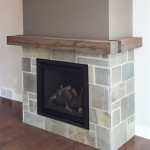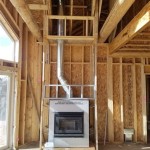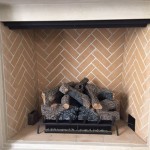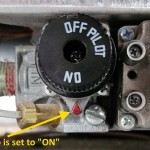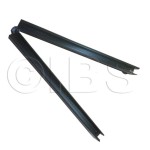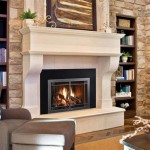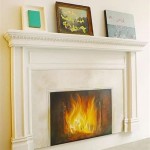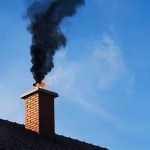Building a Fireplace Surround: A Comprehensive Guide
A fireplace surround serves as the visual anchor for the fireplace, acting as both a decorative element and a protective barrier. It frames the firebox, enhancing the overall aesthetic of the room while providing a heat-resistant surface. Constructing a fireplace surround involves careful planning, precise measurements, and an understanding of building materials and techniques. This article provides a comprehensive guide to the process.
Before embarking on the project, it is crucial to understand local building codes and regulations pertaining to fireplace construction. These codes ensure safety and prevent potential hazards. Furthermore, the type of fireplace (gas, wood-burning, or electric) dictates specific clearances and material requirements. A thorough understanding of these specifications is paramount to a successful and compliant installation.
The design of the fireplace surround is a crucial step. The chosen aesthetic should complement the existing décor of the room and reflect personal preferences. Common styles range from traditional to modern, with variations incorporating elements like mantels, shelves, and various material combinations. The size of the firebox opening and the overall dimensions of the fireplace wall will influence the design. Draw detailed sketches and consider using design software to visualize the finished product.
Key Point 1: Planning and Preparation
The initial stage involves meticulous planning and preparation. This encompasses several critical steps.
First, accurate measurements of the existing fireplace and surrounding wall are essential. Measure the width and height of the firebox opening, the depth of the firebox, and the dimensions of the area designated for the surround. These measurements will dictate the size and shape of the frame and facing.
Second, material selection is critical. Common materials include wood, stone, brick, tile, and metal. Wood is a popular choice for its versatility and ease of construction. Stone and brick offer a more traditional and durable option, while tile provides a wide range of design possibilities. Metal can add a modern and industrial touch. Select materials that are fire-resistant and suitable for the proximity to the heat source. Consult with a building supply professional to ensure the chosen materials meet safety requirements.
Third, gather the necessary tools and equipment. This typically includes a measuring tape, level, square, circular saw, miter saw, drill, screwdriver, nail gun (optional), safety glasses, dust mask, and appropriate fasteners (nails, screws, or construction adhesive). The specific tools required will depend on the chosen materials and construction techniques.
Fourth, prepare the work area. Protect the surrounding floor and furniture with drop cloths. Ensure adequate ventilation, especially when cutting wood or using adhesives. Clear the area of any obstructions that may hinder the construction process.
Finally, create a detailed cut list based on the design and measurements. This list will specify the dimensions and quantity of each piece of material required for the surround.
Key Point 2: Constructing the Fireplace Surround
The construction phase involves assembling the framework and attaching the facing materials. The specific steps will vary depending on the design and materials chosen, but the following provides a general overview.
First, build the frame. The frame provides the structural support for the facing materials. Typically, it is constructed from wood studs or metal framing. Cut the studs to the required lengths based on the cut list. Assemble the frame using screws or nails, ensuring it is square and level. The frame should be securely attached to the wall using appropriate fasteners.
Second, install a non-combustible layer. This layer acts as a heat shield between the firebox and the surround. Cement board is a common choice for this purpose. Cut the cement board to size and attach it to the frame using screws. Ensure all seams are taped and mudded with cement board joint compound.
Third, attach the facing materials. The facing materials provide the aesthetic appeal of the surround. Wood, stone, brick, tile, or metal can be used for this purpose. Cut the facing materials to size using the appropriate tools. Attach the facing materials to the non-combustible layer using construction adhesive or mortar, depending on the material. Ensure the facing materials are aligned and level.
Fourth, install the mantel (optional). The mantel is a decorative shelf that sits above the firebox. Cut the mantel to size and attach it to the frame using screws or construction adhesive. Ensure the mantel is level and securely attached. Add any decorative molding or trim to enhance the appearance of the mantel.
Fifth, apply finishing touches. This may include painting, staining, or sealing the wood, grouting the tile, or applying a protective coating to the stone or brick. These finishing touches will enhance the appearance and durability of the surround.
Throughout the construction process, constantly check for plumb and level using a level. This ensures that the surround is square and visually appealing. Regular measurements will prevent errors and ensure a professional-looking finish.
Key Point 3: Safety Considerations and Fireplace Type Specifics
Safety is paramount when building a fireplace surround. Neglecting safety precautions can result in fire hazards and potential injuries. The type of fireplace dictates specific clearances and material requirements.
First, maintain proper clearances. Ensure that combustible materials are kept a safe distance from the firebox opening. The specific clearances will depend on the type of fireplace and the manufacturer's recommendations. Refer to the fireplace's installation manual for detailed clearance requirements.
Second, use fire-resistant materials. All materials used in the construction of the surround should be fire-resistant or non-combustible. Wood should be treated with a fire-retardant coating. Stone, brick, tile, and metal are inherently fire-resistant.
Third, ensure proper ventilation. The fireplace should have adequate ventilation to allow for proper combustion and prevent the buildup of harmful gases. Check the fireplace's installation manual for ventilation requirements.
Fourth, carbon monoxide detectors. Install carbon monoxide detectors in the vicinity of the fireplace. Carbon monoxide is a colorless, odorless gas that can be deadly. Detectors will provide an early warning of a carbon monoxide leak.
Fifth, Gas Fireplace Considerations: Gas fireplaces necessitate careful attention to gas line connections. All gas connections must be performed by a licensed professional to prevent leaks and ensure safe operation. Similarly, ventless gas fireplaces possess very specific clearance and ventilation demands to prevent carbon monoxide issues. These models necessitate strict adherence to manufacturer instructions and local codes.
Sixth, Wood-Burning Fireplace Considerations: Wood-burning fireplaces produce significant heat. Use thicker, more substantial non-combustible materials and adhere to larger clearance distances than those required for gas or electric fireplaces. Regular chimney cleaning and inspections are necessary to prevent creosote buildup, a highly flammable residue that can cause chimney fires.
Seventh, Electric Fireplace Considerations: Electric fireplaces present the fewest installation challenges, though some still emit heat. Review manufacturer specifications for any required clearances. The primary concern is ensuring adequate electrical supply and that the circuit can handle the fireplace's power requirements. Never overload electrical circuits.
Eighth, always consult with a qualified professional. If you are unsure about any aspect of the fireplace surround construction, consult with a qualified contractor or building inspector. They can provide guidance and ensure that the project is completed safely and in accordance with local building codes.
By adhering to these safety precautions and consulting with professionals when needed, the construction of a fireplace surround can be a safe and rewarding project. The result is a beautiful and functional addition to any home. Always double-check all measurements and ensure stability before considering the project complete.

Diy Fireplace Mantel Designatedspacedesign Com

How To Build A Faux Fireplace Mantel And Surround The Home Depot

How To Build A Fireplace Mantel And Surround Ana White

Easy Fireplace Mantel Diy

How To Build A Modern Fireplace Surround Hana S Happy Home

How To Build A Diy Built In Fireplace With An Electric Insert The Creative Mom

How To Make A Fireplace Surround
:max_bytes(150000):strip_icc()/sandandsisal-bdc76ad938a44d28ae9e23ef6c9fa331.jpg?strip=all)
17 Diy Fireplace Mantel Plans

Diy Fireplace With Electric Insert Angela Marie Made

How To Build A Shaker Fireplace Mantel And Surround Woodworking Diy Project Plans You Can Make It
Related Posts

